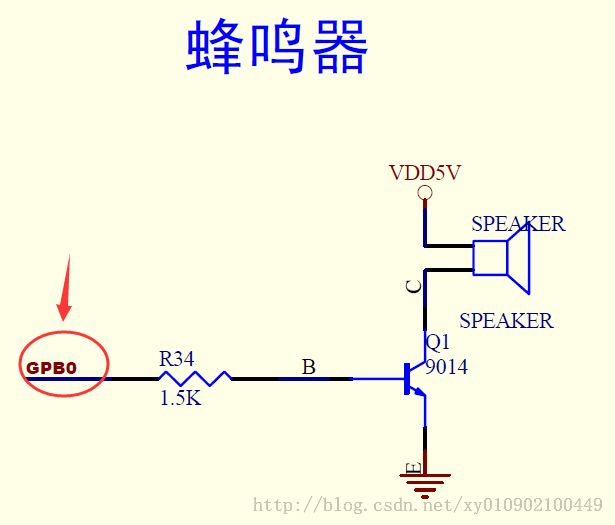mini2440_pwm.c 分析(PWM 驱动)
1、概述
本驱动用定时器0产生PWM脉冲信号,GPB0管脚输出接蜂鸣器。
mini2440共有5个定时器,不过只有Timer 0~4具有PWM功能
2、驱动程序
#include <linux/module.h>
#include <linux/kernel.h>
#include <linux/fs.h>
#include <linux/init.h>
#include <linux/delay.h>
#include <linux/poll.h>
#include <linux/interrupt.h>
#include <linux/gpio.h>
#include <asm/irq.h>
#include <asm/io.h>
#include <asm/uaccess.h>
#include <mach/regs-gpio.h>
#include <mach/hardware.h>
#include <plat/regs-timer.h>
#include <mach/regs-irq.h>
#include <asm/mach/time.h>
#include <linux/clk.h>
#include <linux/cdev.h>
#include <linux/device.h>
#include <linux/miscdevice.h>
#define DEVICE_NAME "pwm"
#define PWM_IOCTL_SET_FREQ 1 //设置pwm的频率
#define PWM_IOCTL_STOP 0 //停止pwm
//定义信号量,此处的信号量是一个互斥信号量,用于PWM设备之多只能被一个进程打开
static struct semaphore lock;
/* freq: pclk/50/16/65536 ~ pclk/50/16
* if pclk = 50MHz, freq is 1Hz to 62500Hz
* human ear : 20Hz~ 20000Hz
主要是对操作pwm的寄存器进行设置,跟裸机的设置一样,
但是可以看出,驱动程序中设置寄存器都是采用读、修改、写的方式进行的。
*/
static void PWM_Set_Freq( unsigned long freq )
{
unsigned long tcon;
unsigned long tcnt;
unsigned long tcfg1;
unsigned long tcfg0;
struct clk *clk_p;
unsigned long pclk;
//set GPB0 as tout0, pwm output
s3c2410_gpio_cfgpin(S3C2410_GPB(0), S3C2410_GPB0_TOUT0);//设置GPB0为tout0,pwm输出
tcon = __raw_readl(S3C2410_TCON); //读取寄存器TCON到tcon
tcfg1 = __raw_readl(S3C2410_TCFG1); //读取寄存器TCFG1到tcfg1
tcfg0 = __raw_readl(S3C2410_TCFG0); //读取寄存器TCFG0到tcfg0
//prescaler = 50
//清除prescaler 0 [7:0]位
tcfg0 &= ~S3C2410_TCFG_PRESCALER0_MASK; // S3C2410_TCFG_PRESCALER0_MASK定时器0和1的预分频值的掩码,TCFG[0~8]
//设置prescaler 0 [7:0]位
tcfg0 |= (50 - 1); // 预分频为50HZ
//mux = 1/16 详细请看数据手册
tcfg1 &= ~S3C2410_TCFG1_MUX0_MASK; //S3C2410_TCFG1_MUX0_MASK定时器0分割值的掩码:TCFG1[0~3]
tcfg1 |= S3C2410_TCFG1_MUX0_DIV16; //定时器0进行16分割
__raw_writel(tcfg1, S3C2410_TCFG1); //把新配置tcfg1的值写到分割寄存器S3C2410_TCFG1中
__raw_writel(tcfg0, S3C2410_TCFG0); //把tcfg0的值写到预分频寄存器S3C2410_TCFG0中
clk_p = clk_get(NULL, "pclk"); //得到pclk
pclk = clk_get_rate(clk_p);
tcnt = (pclk/50/16)/freq; //得到定时器的输入时钟,进而设置PWM的调制频率
__raw_writel(tcnt, S3C2410_TCNTB(0)); //PWM脉宽调制的频率等于定时器的输入时钟
__raw_writel(tcnt/2, S3C2410_TCMPB(0)); //占空比是50% ,自己认为是高电平时间
//配置定时器
tcon &= ~0x1f;//清空前4位
tcon |= 0xb; //disable deadzone, auto-reload, inv-off, update TCNTB0&TCMPB0, start timer 0
__raw_writel(tcon, S3C2410_TCON);
tcon &= ~2; //clear manual update bit
__raw_writel(tcon, S3C2410_TCON); //把tcon写到计数器控制寄存器S3C2410_TCON中
}
static void PWM_Stop(void)
{
s3c2410_gpio_cfgpin(S3C2410_GPB(0), S3C2410_GPIO_OUTPUT); //设置GPB0为输出
s3c2410_gpio_setpin(S3C2410_GPB(0), 0); //设置GPB0为低电平,使蜂鸣器停止
}
static int s3c24xx_pwm_open(struct inode *inode, struct file *file)
{
if (!down_trylock(&lock))//判断是否设备已经打开,已打开返回EBUSY
return 0; //是否获得信号量,是down_trylock(&lock)=0,否则非0
else
return -EBUSY;
}
static int s3c24xx_pwm_close(struct inode *inode, struct file *file)
{
PWM_Stop();//停止PWM
up(&lock);//释放信号量
return 0;
}
/*这个pwm驱动的基本功能体现在ioctl方法上
可以看出,只提供两个选项,一个是设置频率(调用PWM_Set_Freq函数),
一个是停止。其他的功能都没有,这充分体现驱动程序中 “提供机制而不是提供策略”的思想,
驱动程序中只提供基本的功能实现,其他复杂的功能由应用程序提供。*/
static int s3c24xx_pwm_ioctl(struct inode *inode, struct file *file, unsigned int cmd, unsigned long arg)
{
//printk("ioctl pwm: %x %lx\n", cmd, arg);
switch (cmd) {
case PWM_IOCTL_SET_FREQ:
if (arg == 0){
return -EINVAL;
}
PWM_Set_Freq(arg);//设置频率
break;
case PWM_IOCTL_STOP:
PWM_Stop();
break;
}
return 0;
}
/*初始化设备的文件操作的结构体*/
static struct file_operations dev_fops = {
.owner = THIS_MODULE,
.open = s3c24xx_pwm_open,
.release = s3c24xx_pwm_close,
.ioctl = s3c24xx_pwm_ioctl,
};
static struct miscdevice misc = {
.minor = MISC_DYNAMIC_MINOR,
.name = DEVICE_NAME,
.fops = &dev_fops,
};
/*pwm驱动也是作为杂项设备注册的,同样为了防止并发造成的竞态,有个信号量保护。模块的初始化函数
这个函数就是初始化了一个信号量,然后调用misc_register注册到杂项设备*/
static int __init dev_init(void)
{
int ret;
init_MUTEX(&lock); //初始化一个互斥锁
ret = misc_register(&misc);
printk (DEVICE_NAME"\tinitialized\n");
return ret;
}
static void __exit dev_exit(void)
{
misc_deregister(&misc);
}
module_init(dev_init);
module_exit(dev_exit);
MODULE_LICENSE("GPL");
MODULE_AUTHOR("FriendlyARM Inc.");
MODULE_DESCRIPTION("S3C2410/S3C2440 PWM Driver");
3、测试程序

